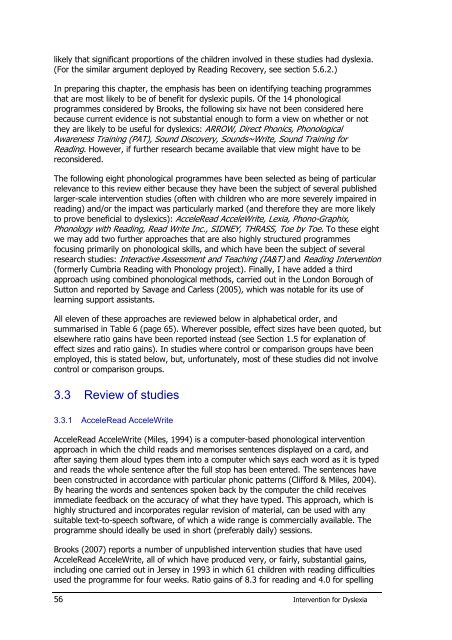Intervention for Dyslexia - The British Dyslexia Association
Intervention for Dyslexia - The British Dyslexia Association
Intervention for Dyslexia - The British Dyslexia Association
You also want an ePaper? Increase the reach of your titles
YUMPU automatically turns print PDFs into web optimized ePapers that Google loves.
likely that significant proportions of the children involved in these studies had dyslexia.<br />
(For the similar argument deployed by Reading Recovery, see section 5.6.2.)<br />
In preparing this chapter, the emphasis has been on identifying teaching programmes<br />
that are most likely to be of benefit <strong>for</strong> dyslexic pupils. Of the 14 phonological<br />
programmes considered by Brooks, the following six have not been considered here<br />
because current evidence is not substantial enough to <strong>for</strong>m a view on whether or not<br />
they are likely to be useful <strong>for</strong> dyslexics: ARROW, Direct Phonics, Phonological<br />
Awareness Training (PAT), Sound Discovery, Sounds~Write, Sound Training <strong>for</strong><br />
Reading. However, if further research became available that view might have to be<br />
reconsidered.<br />
<strong>The</strong> following eight phonological programmes have been selected as being of particular<br />
relevance to this review either because they have been the subject of several published<br />
larger-scale intervention studies (often with children who are more severely impaired in<br />
reading) and/or the impact was particularly marked (and there<strong>for</strong>e they are more likely<br />
to prove beneficial to dyslexics): AcceleRead AcceleWrite, Lexia, Phono-Graphix,<br />
Phonology with Reading, Read Write Inc., SIDNEY, THRASS, Toe by Toe. To these eight<br />
we may add two further approaches that are also highly structured programmes<br />
focusing primarily on phonological skills, and which have been the subject of several<br />
research studies: Interactive Assessment and Teaching (IA&T) and Reading <strong>Intervention</strong><br />
(<strong>for</strong>merly Cumbria Reading with Phonology project). Finally, I have added a third<br />
approach using combined phonological methods, carried out in the London Borough of<br />
Sutton and reported by Savage and Carless (2005), which was notable <strong>for</strong> its use of<br />
learning support assistants.<br />
All eleven of these approaches are reviewed below in alphabetical order, and<br />
summarised in Table 6 (page 65). Wherever possible, effect sizes have been quoted, but<br />
elsewhere ratio gains have been reported instead (see Section 1.5 <strong>for</strong> explanation of<br />
effect sizes and ratio gains). In studies where control or comparison groups have been<br />
employed, this is stated below, but, un<strong>for</strong>tunately, most of these studies did not involve<br />
control or comparison groups.<br />
3.3 Review of studies<br />
3.3.1 AcceleRead AcceleWrite<br />
AcceleRead AcceleWrite (Miles, 1994) is a computer-based phonological intervention<br />
approach in which the child reads and memorises sentences displayed on a card, and<br />
after saying them aloud types them into a computer which says each word as it is typed<br />
and reads the whole sentence after the full stop has been entered. <strong>The</strong> sentences have<br />
been constructed in accordance with particular phonic patterns (Clif<strong>for</strong>d & Miles, 2004).<br />
By hearing the words and sentences spoken back by the computer the child receives<br />
immediate feedback on the accuracy of what they have typed. This approach, which is<br />
highly structured and incorporates regular revision of material, can be used with any<br />
suitable text-to-speech software, of which a wide range is commercially available. <strong>The</strong><br />
programme should ideally be used in short (preferably daily) sessions.<br />
Brooks (2007) reports a number of unpublished intervention studies that have used<br />
AcceleRead AcceleWrite, all of which have produced very, or fairly, substantial gains,<br />
including one carried out in Jersey in 1993 in which 61 children with reading difficulties<br />
used the programme <strong>for</strong> four weeks. Ratio gains of 8.3 <strong>for</strong> reading and 4.0 <strong>for</strong> spelling<br />
56 <strong>Intervention</strong> <strong>for</strong> <strong>Dyslexia</strong>









